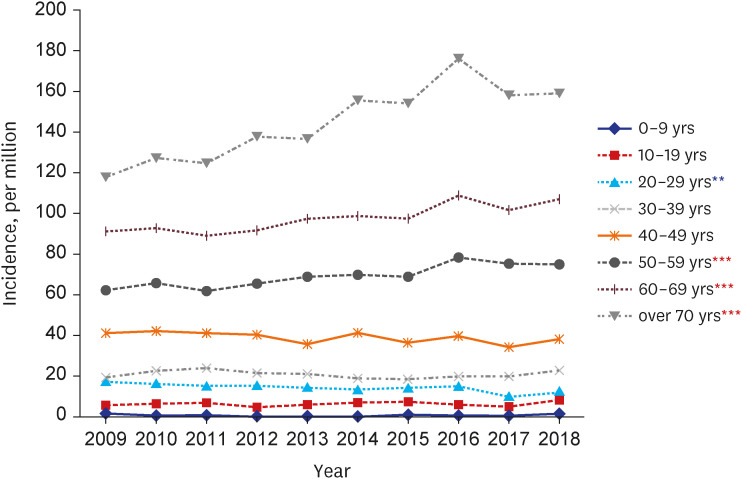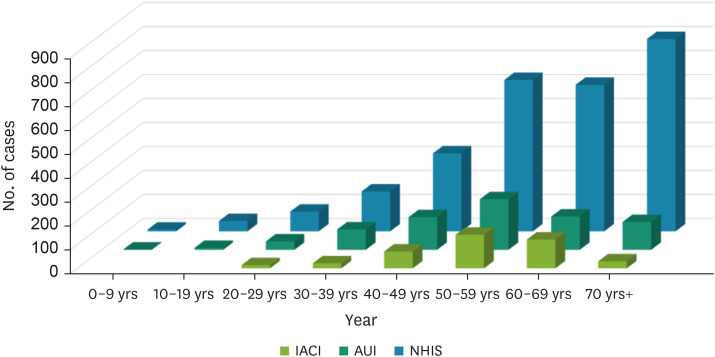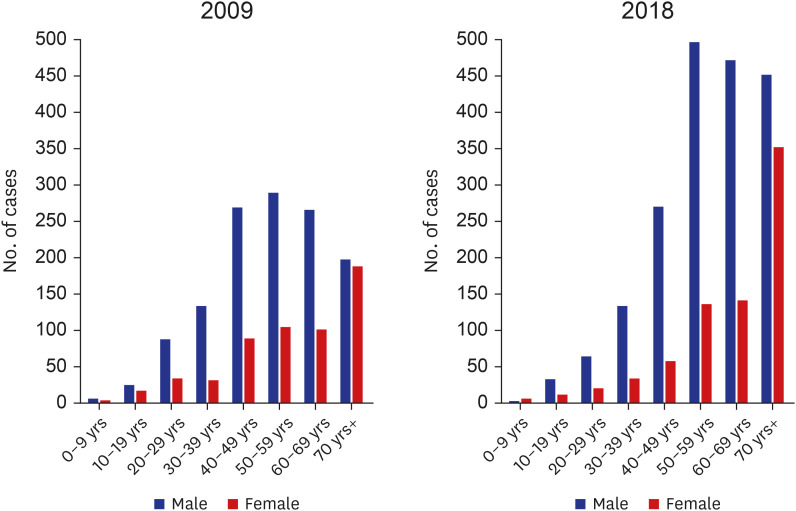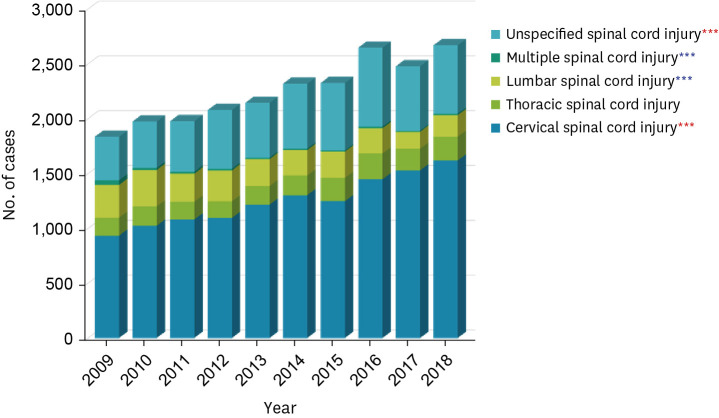J Korean Med Sci.
2023 Feb;38(7):e26. 10.3346/jkms.2023.38.e26.
Comparison of Trends in the Incidence of Traumatic Spinal Cord Injury in Daily Life, Automobile Accidents, and Industrial Accidents: A National Multi-Insurance Study in Korea
- Affiliations
-
- 1Department of Rehabilitation Medicine, Seoul National University Hospital, Seoul, Korea
- 2National Traffic Injury Rehabilitation Research Institute, National Traffic Injury Rehabilitation Hospital, Yangpyeong, Korea
- 3Department of Big Data Strategy, National Health Insurance Service, Wonju, Korea
- 4Department of Rehabilitation Medicine, National Traffic Injury Rehabilitation Hospital, Yangpyeong, Korea
- 5Institute of Health Policy and Management, Medical Research Center, Seoul National University, Seoul, Korea
- 6Department of Rehabilitation Medicine, Korea Workers’ Compensation and Welfare Incheon Hospital, Incheon, Korea
- 7Rehabilitation Medicine Research Center, Korea Workers’ Compensation and Welfare Service Incheon Hospital, Incheon, Korea
- KMID: 2539532
- DOI: http://doi.org/10.3346/jkms.2023.38.e26
Abstract
- Background
To examine the incidence of traumatic spinal cord injury (TSCI) from all etiologies, we measured and compared the incidence of TSCI from three national or quasinational databases in South Korea, namely, the National Health Insurance Service (NHIS), automobile insurance (AUI), and Industrial Accident Compensation Insurance (IACI).
Methods
We reviewed patients with TSCI reported in the NHIS database between 2009 and 2018, and in the AUI and IACI databases between 2014 and 2018. TSCI patients were defined as those first admitted to the hospital with a diagnosis of TSCI according to the International Classification of Diseases (10th revision) criteria. Age-adjusted incidence was calculated using direct standardization using the 2005 South Korean population or the 2000 US population as the standard population. The annual percentage changes (APC) of TSCI incidence were calculated. The Cochrane–Armitage trend test was performed according to the injured body region.
Results
In the NHIS database, age-adjusted TSCI incidence using the Korean standard population increased significantly from 2009 to 2018 (from 33.73 per million in 2009 to 38.14 per million in 2018, APC = 1.2%, P = 0.014). Contrarily, age-adjusted incidence in the AUI database significantly decreased from 13.88 per million in 2014 to 11.57 per million in 2018 (APC = – 5.1%, P = 0.009). In the IACI database, the age-adjusted incidence showed no significant difference, while crude incidence showed a significant increase (from 22.02 per million in 2014 to 28.92 per million in 2018, APC = 6.1%, P = 0.038). According to the age group, all the three databases showed high incidences of TSCI in those in their 60s and 70s or older. Among those in their 70s or older, the incidence of TSCI increased dramatically in the NHIS and IACI databases, while no significant trend was found in AUI database. In 2018, the number of TSCI patients was the highest among those over 70 years of age in the NHIS, whereas among those in their 50s were the highest in both AUI and IACI. The proportion of patients with cervical spinal cord injury was the most common in all these databases.
Conclusions
The differences in trends in the incidence of TSCI may be due to the different etiologies and different characteristics of subjects depending on insurance type. These results imply the need for tailored medical strategies for the different injury mechanisms represented by three national insurance services in South Korea.
Keyword
Figure
Cited by 1 articles
-
Trends in the Incidence and Etiology of Non-Traumatic Spinal Cord Injury in Korea: A Nationwide Population-Based Study From 2007 to 2020
Yoonjeong Choi, Ja-Ho Leigh, Jooeun Jeon, Goo Joo Lee, Hyung-Ik Shin, Moon Suk Bang
J Korean Med Sci. 2023;38(18):e158. doi: 10.3346/jkms.2023.38.e158.
Reference
-
1. Kumar R, Lim J, Mekary RA, Rattani A, Dewan MC, Sharif SY, et al. Traumatic spinal injury: global epidemiology and worldwide volume. World Neurosurg. 2018; 113:e345–e363. PMID: 29454115.
Article2. Miyakoshi N, Suda K, Kudo D, Sakai H, Nakagawa Y, Mikami Y, et al. A nationwide survey on the incidence and characteristics of traumatic spinal cord injury in Japan in 2018. Spinal Cord. 2021; 59(6):626–634. PMID: 32782342.
Article3. Yang NP, Deng CY, Lee YH, Lin CH, Kao CH, Chou P. The incidence and characterisation of hospitalised acute spinal trauma in Taiwan--a population-based study. Injury. 2008; 39(4):443–450. PMID: 18321510.
Article4. Liu P, Yao Y, Liu MY, Fan WL, Chao R, Wang ZG, et al. Spinal trauma in mainland China from 2001 to 2007: an epidemiological study based on a nationwide database. Spine (Phila Pa 1976). 2012; 37(15):1310–1315. PMID: 22744399.5. Szczotkowski D, Neik C, Polak U, Wittwer M, Kohlmann T. Evaluation of medical insurance consultant reports within the German Statutory Accident Insurance-Methodology and results of a peer review procedure. Unfallchirurg. 2021; 124(1):48–58.
Article6. Zhang B, Chen G, Chen X, Sun C, Chen Z. Cervical ossification of ligamentum flavum: elaborating an underappreciated but occasional contributor to myeloradiculopathy in aging population based on synthesis of individual participant data. Clin Interv Aging. 2021; 16:897–908. PMID: 34079239.
Article7. Lewin AM, Fearnside M, Kuru R, Jonker BP, Naylor JM, Sheridan M, et al. Rates, costs, return to work and reoperation following spinal surgery in a workers’ compensation cohort in New South Wales, 2010–2018: a cohort study using administrative data. BMC Health Serv Res. 2021; 21(1):955. PMID: 34511093.
Article8. Cheol Seong S, Kim YY, Khang YH, Heon Park J, Kang HJ, Lee H, et al. Data resource profile: the National Health Information Database of the National Health Insurance Service in South Korea. Int J Epidemiol. 2017; 46(3):799–800. PMID: 27794523.
Article9. Song SO, Jung CH, Song YD, Park CY, Kwon HS, Cha BS, et al. Background and data configuration process of a nationwide population-based study using the Korean national health insurance system. Diabetes Metab J. 2014; 38(5):395–403. PMID: 25349827.
Article10. Kim I, Rhie J, Yoon JD, Kim J, Won J. Current situation and issue of Industrial Accident Compensation insurance. J Korean Med Sci. 2012; 27(Suppl):S47–S54. PMID: 22661871.
Article11. Jeon I, Leigh JH, Ro JS, Ro YS, Lee SH, Shin HI, et al. Trends in the incidence of work-related traumatic limb amputations in South Korea from 2004 to 2013. Prosthet Orthot Int. 2019; 43(4):409–417. PMID: 30922171.
Article12. Kim HJ, Fay MP, Feuer EJ, Midthune DN. Permutation tests for joinpoint regression with applications to cancer rates. Stat Med. 2000; 19(3):335–351. PMID: 10649300.
Article13. Lee BS, Kim O, Ham D. Epidemiological changes in traumatic spinal cord injuries for the last 30 years (1990–2019) in South Korea. Spinal Cord. 2022; 60(7):612–617. PMID: 34465888.
Article14. Shin JC, Kim DH, Yu SJ, Yang HE, Yoon SY. Epidemiologic change of patients with spinal cord injury. Ann Rehabil Med. 2013; 37(1):50–56. PMID: 23525183.
Article15. Jain NB, Ayers GD, Peterson EN, Harris MB, Morse L, O’Connor KC, et al. Traumatic spinal cord injury in the United States, 1993–2012. JAMA. 2015; 313(22):2236–2243. PMID: 26057284.
Article16. Beck B, Cameron PA, Braaf S, Nunn A, Fitzgerald MC, Judson RT, et al. Traumatic spinal cord injury in Victoria, 2007-2016. Med J Aust. 2019; 210(8):360–366. PMID: 31055854.
Article17. Ferro S, Cecconi L, Bonavita J, Pagliacci MC, Biggeri A, Franceschini M. Incidence of traumatic spinal cord injury in Italy during 2013–2014: a population-based study. Spinal Cord. 2017; 55(12):1103–1107. PMID: 28872148.
Article18. Kow CY, Chan P, Etherington G, Rosenfeld JV. Acute traumatic cord injury associated with ossified ligamentum flavum. J Clin Neurosci. 2016; 30:165–166. PMID: 27052256.
Article19. Cripps RA, Lee BB, Wing P, Weerts E, Mackay J, Brown D. A global map for traumatic spinal cord injury epidemiology: towards a living data repository for injury prevention. Spinal Cord. 2011; 49(4):493–501. PMID: 21102572.
Article20. Choi SH, Sung CH, Heo DR, Jeong SY, Kang CN. Incidence of acute spinal cord injury and associated complications of methylprednisolone therapy: a national population-based study in South Korea. Spinal Cord. 2020; 58(2):232–237. PMID: 31527724.
Article21. Rah UW, Moon HW, Lim MJ. A survey on spinal cord injury persons in Suwon City. J Korean Acad Rehab Med. 2000; 24(1):42–51.22. Shin H. Etiology and epidemiology of spinal cord injury in Korea. J Korean Med Assoc. 2020; 63(10):589–595.
Article23. Yang JY, Kim TK, Moon ES, Sohn HM, Hong CH, Nah KH, et al. Epidemiology of the spinal cord and cauda equina injury in Korea: multicenter study. J Korean Soc Spine Surg. 2011; 18(3):83–90.
Article
- Full Text Links
- Actions
-
Cited
- CITED
-
- Close
- Share
- Similar articles
-
- Paraplegia Following Spinal Cord Contusion from an Indirect Gunshot Injury
- Spinal Cord Injury Fact Sheet in Korea
- Industrial Accident Compensation Insurance Coverage and Industrial Accidents among Concrete Mixer Truck Drivers
- A Status of the Report for Industrial Injuries and Illnesses at an Automobile Related Plant
- Spinal Cord Injury Followign Electrical Accidents : Case Reports





